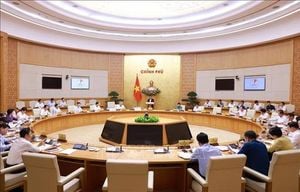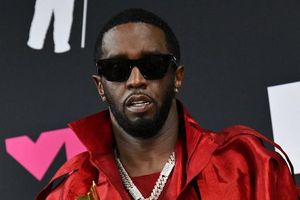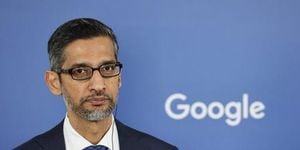Bright, shimmering lights hovering just above Capitol Hill have sent waves of speculation ripple through Washington, D.C., igniting discussions about extraterrestrial life and unidentified flying objects (UFOs). The viral image, captured by US Air Force veteran Dennis Diggins, showcases four enigmatic lights eerily perched above the iconic Statue of Freedom atop the Capitol dome. Taken during the nighttime, this startling photo was quickly disseminated on social media, provoking fears of impending alien contacts among netizens.
Diggins, who now works as a licensed tour guide and travel director, might not have anticipated the frenzy his snapshot would spark. Others immediately began sharing their takes on what these glowing orbs could signal. A video taken from another angle claimed to show the same lights shifting formation—a change from the original square shape to a straight line—adding to the growing mystery. This newfound visibility of bizarre lights coincided with recent congressional hearings concerning unexplained aerial phenomena, linking the two events and pushing the narrative even farther.
The timing of Diggins’ photo is particularly poignant. Just weeks ago, Congress held hearings examining claims surrounding secret government programs allegedly involving alien spacecraft research. During these sessions, military personnel offered testimony about encounters with objects exhibiting flight patterns and structures not found within the traditional arsenal, leaving many entranced by the possibility of non-human intelligence.
“That’s absolutely insane!” exclaimed one observer, fanning the flames of speculation about whether or not aliens were observing humanity from above. Social media quickly became abuzz, with various users lamenting on how the “alien invasion” might finally be upon them. "Maybe we should prepare for intergalactic visitors," joked one Twitter user, trying to grasp the surreal nature of the sighting.
Not everyone, though, is convinced by the UFO theory. Some experts rushed to refute the notion of aliens visiting Capitol Hill, attributing the unusual lights to reflections caused by the Capitol building’s lighting and atmospheric conditions. John Greenewald Jr., a researcher and ufologist, proposed via social media platform X, previously Twitter, “The lights at the U.S. Capitol building have been causing ‘UFO sightings’ in the camera lens for decades & decades,” emphasizing the frequent misidentification of such visuals. He underscored his skepticism by dubbing them "just lens flares," asserting they were more of the same phenomenon people have reportedly misread for years.
Adding another layer of intrigue was the Pentagon’s assertion earlier this year, stating it had uncovered no evidence linking the sightings to extraterrestrial origins. A report released cited, "All investigative efforts, at all levels of classification, concluded most sightings were ordinary objects and phenomena and the result of misidentification." This official stance has done little to cool the heated discussions online, as the tension between speculation and denial continues.
The connection between Diggins’ photograph and the previous congressional hearings becomes evident as public interest peaks. The hearings have allowed discussions around Unidentified Anomalous Phenomena (UAP) and their potential to reveal truths about intelligence previously veiled by secrecy. Witnesses expressed frustration over what they see as long-standing cover-ups, alleging government intimidation tactics against those who have sought transparency.
Particularly noteworthy is the atmosphere of curiosity surrounding this investigation, as figures like former counterintelligence officers, ex-NASA officials, and retired military leaders joined the calls for greater recognition of UAP. The compelling testimony has led some advocates to theorize on the advancements of aerial technologies and their sources, raising more questions than answers.
The intersection of alleged UFO sightings and political undertones continues to elicit complicated reactions from various corners of society. The potential for UFOs to disrupt or influence governmental matters far exceeds the boundaries of science fiction for many who witness the glow over Capitol Hill. Some are left wondering what shapes the future discussions about such sightings will take—whether they be accompanied by fear, excitement, or simply more questions.
Despite varying opinions on whether the lights signify something otherworldly, the city remains captivated by the idea of UFOs lurking among the monuments, blending fact with fiction as they navigate the constant dialogue around extraterrestrial life. And with modern cameras constantly capturing potential UAP, the debate around their existence seems far from fading.
A curious echo of the scene might still linger; curiosity often provokes more inquiries. It is undeniably tempting to ponder the larger questions these events reveal about our place within the cosmos. To date, the lasting allure of such images remains, and they well fuel our collective imagination as society appears to be poised on the cusp of discovering truths previously relegated to fiction.



